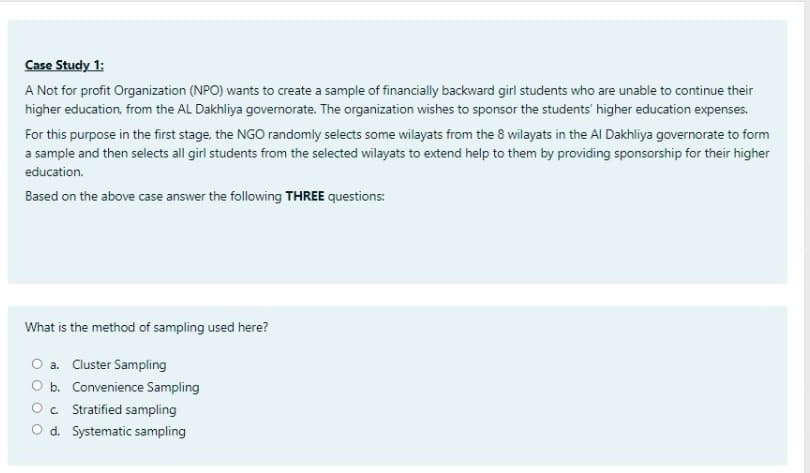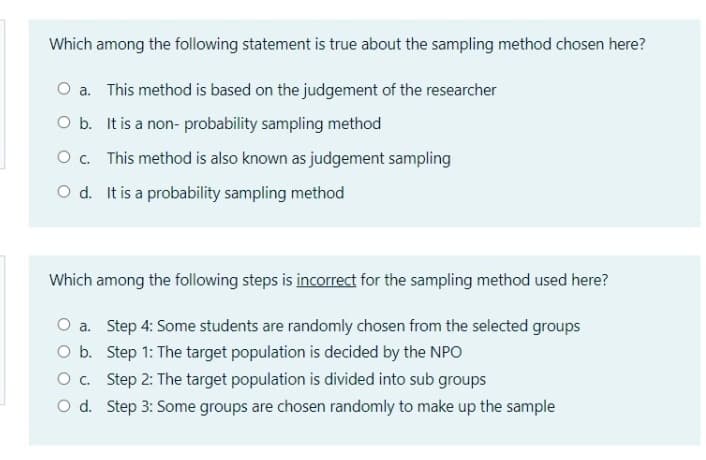Case Study 1: A Not for profit Organization (NPO) wants to create a sample of financially backward girl students who are unable to continue their higher education, from the AL Dakhliya governorate. The organization wishes to sponsor the students' higher education expenses. For this purpose in the first stage, the NGO randomly selects some wilayats from the 8 wilayats in the Al Dakhliya governorate to form a sample and then selects all girl students from the selected wilayats to extend help to them by providing sponsorship for their higher education. Based on the above case answer the following THREE questions: What is the method of sampling used here? O a. Cluster Sampling
Case Study 1: A Not for profit Organization (NPO) wants to create a sample of financially backward girl students who are unable to continue their higher education, from the AL Dakhliya governorate. The organization wishes to sponsor the students' higher education expenses. For this purpose in the first stage, the NGO randomly selects some wilayats from the 8 wilayats in the Al Dakhliya governorate to form a sample and then selects all girl students from the selected wilayats to extend help to them by providing sponsorship for their higher education. Based on the above case answer the following THREE questions: What is the method of sampling used here? O a. Cluster Sampling
Intermediate Algebra
10th Edition
ISBN:9781285195728
Author:Jerome E. Kaufmann, Karen L. Schwitters
Publisher:Jerome E. Kaufmann, Karen L. Schwitters
Chapter3: Polynomials
Section3.S: Summary
Problem 9S
Related questions
Question

Transcribed Image Text:Case Study 1:
A Not for profit Organization (NPO) wants to create a sample of financially backward girl students who are unable to continue their
higher education, from the AL Dakhliya governorate. The organization wishes to sponsor the students' higher education expenses.
For this purpose in the first stage, the NGO randomly selects some wilayats from the 8 wilayats in the Al Dakhliya governorate to form
a sample and then selects all girl students from the selected wilayats to extend help to them by providing sponsorship for their higher
education.
Based on the above case answer the following THREE questions:
What is the method of sampling used here?
O a. Cluster Sampling
O b. Convenience Sampling
O. Stratified sampling
O d. Systematic sampling

Transcribed Image Text:Which among the following statement is true about the sampling method chosen here?
O a. This method is based on the judgement of the researcher
O b. It is a non- probability sampling method
O. This method is also known as judgement sampling
O d. It is a probability sampling method
Which among the following steps is incorrect for the sampling method used here?
O a. Step 4: Some students are randomly chosen from the selected groups
O b. Step 1: The target population is decided by the NPO
O c. Step 2: The target population is divided into sub groups
O d. Step 3: Some groups are chosen randomly to make up the sample
Expert Solution
This question has been solved!
Explore an expertly crafted, step-by-step solution for a thorough understanding of key concepts.
This is a popular solution!
Trending now
This is a popular solution!
Step by step
Solved in 2 steps

Recommended textbooks for you

Intermediate Algebra
Algebra
ISBN:
9781285195728
Author:
Jerome E. Kaufmann, Karen L. Schwitters
Publisher:
Cengage Learning

Algebra for College Students
Algebra
ISBN:
9781285195780
Author:
Jerome E. Kaufmann, Karen L. Schwitters
Publisher:
Cengage Learning

Intermediate Algebra
Algebra
ISBN:
9781285195728
Author:
Jerome E. Kaufmann, Karen L. Schwitters
Publisher:
Cengage Learning

Algebra for College Students
Algebra
ISBN:
9781285195780
Author:
Jerome E. Kaufmann, Karen L. Schwitters
Publisher:
Cengage Learning